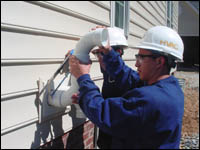Young Workers - Construction: Build a Safe Work Foundation
On-the-Job Hazards
Working teens do not expect to die as a result of their job; but in fact, teens do die from work injuries. Perform a youth fatality search on the National Institute for Occupational Safety and Health - Fatality Assessment and Control Evaluation (FACE) Program. You may be surprised by what you learn!
-
This 15-minute video highlights the four leading causes of fatalities on construction sites. Learn more about the joint safety responsibilities of government, management, and employees.

Despite its high fatality rate, construction can be a safe occupation when employees are aware of the hazards, and use an effective safety and health program. Check out this Construction eTool, available in English and Spanish, to help you identify and control the hazards that commonly cause the most serious construction injuries. Some hazards may even require special personal protective equipment (PPE). Some PPE is meant to protect your breathing; while others protect your eyes and face. Still others protect you from hearing loss.
A construction site has many hazards. These hazards may include:
-
Machine Safety
 . This equipment is commonplace on a construction site. Look and listen -- know what is around you at all times.
. This equipment is commonplace on a construction site. Look and listen -- know what is around you at all times. -
Heat
-
See OSHA's Safety and Health Topics Page: Heat Exposure
-
See OSHA's Heat Illness Prevention Campaign
-
-
 Rodents, Snakes and Insects. Also available in Spanish.
Rodents, Snakes and Insects. Also available in Spanish. -
Electrical hazards can cause burns, shocks and electrocution (death). Save a life by following these life-saving tips for on the job safety, available in English and Spanish. For more detailed information, consult OSHA's Electrical Safety and Health Topics Page; and to find out about ergonomics and the electrician, click here. Other OSHA Assistance for Electrical Contractors is available.
-
This student manual will keep you fully charged for electrical safety.

Lead overexposure is one of the most common overexposures found in industry and is a leading cause of workplace illness. Learn more on limiting exposure and prevention in the Lead in Construction. Also available in Spanish. The Hazard Communication law requires your employer to inform you about this and other workplace chemical hazards. Find out how by clicking here.
-
Not sure of ways to protect yourself from the hazards of permit-required confined spaces? Get your fill by viewing the OSHA QuickCard™. Also available in Spanish. This interactive training program will help you learn more about lockout-tagout procedures.

Trenching can be deadly! Protect yourself with the facts. Get more information by visiting the OSHA Safety and Health Topics page on Trenching and Excavation.
-
Concrete and its dusts can be dangerous to your health. To find out more, click here. The OSHA Safety and Health Topics page: Concrete and Concrete Products - Manufacturing and Construction, provides additional information.

Construction work may require working at heights. Learn more about fall protection. The National Institute for Occupational Safety and Health provides other valuable information on falls from elevations.

